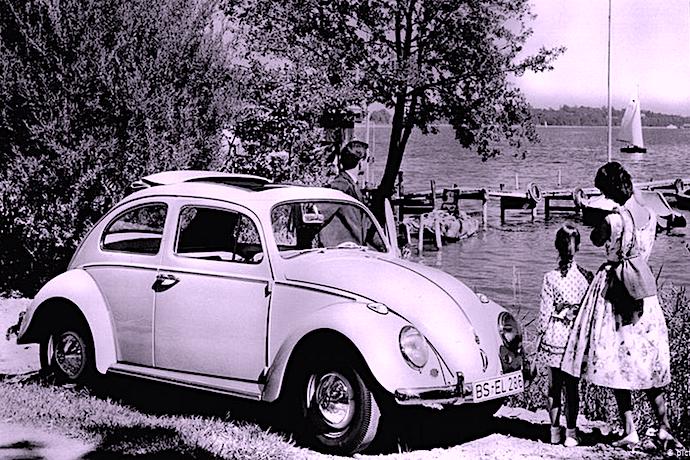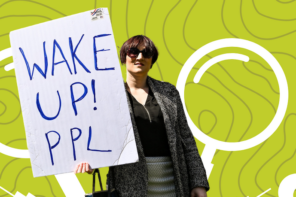Doing research in a branch of the state library in Berlin a few years ago, I stumbled across a reference to a 1951 book called Are There Witches among Us? It had been published in West Germany by a former schoolteacher named Johann Kruse. The title puzzled me, and I assumed the book must be satirical: it couldn’t really be about fears of witches in post-World War II Germany. But surprisingly enough, it was. So I started researching what Kruse called “the modern witch craze.” He was profoundly preoccupied with the social impact of witchcraft accusations, a wave of which crashed over his country in the years just after 1945.
During that period, dozens of what the press referred to as “witchcraft trials” took place. In these cases, the person accused of witchcraft was not the one on trial, as would have been true in Europe in the sixteenth or seventeenth centuries. In the witch trials of the 1950s, the person on trial was the one doing the accusing; and the accusers were often tried for defamation, though also sometimes for more serious charges.
Fears of witchcraft are generally assumed to belong firmly to Europe’s past and are most closely associated with the wide-scale witch hunts that took place during what historians call the early modern period. Yet people accusing each other of being witches never really went away. It simply no longer resulted in clerically or juridically led investigations or executions. Witch fears endured in many parts of Europe, as they have in other parts of the world. But what caused a great spike in accusations after Germany’s defeat in WWII and the destruction of the Third Reich?
Unlike earlier European witch scares, postwar West German witchcraft accusations did not involve carnal relations with the Devil, nocturnal flight, or being able to fall down stairs without sustaining injury. Though they imputed magical evildoing, the accusations mostly involved more mundane human problems, like suspicion, resentment, and festering doubt.
This characteristic aligns with what anthropologists and historians who work on comparative witchcraft have made clear: that while witch fears can take quite different forms across geography and time period, they are often related to matters of intimacy and mistrust, and they erupt in response to instability, insecurity, and unease—moments very much like the one that followed World War II in Germany.
In such moments, dramatic changes can cause the familiar suddenly to appear strange, and even ordinary occurrences may gain grave meaning. A string of misfortunes, like a death or injury or illness coming on the heels of other setbacks, can be perceived as having been not merely accidental but orchestrated by someone, or a conspiracy of someones, in secret, behind the scenes. In those communities where witchcraft acts as an idiom of interpersonal and communal conflict, a way of seeing the world and explaining the events in it, widespread mistrust may make accusations more likely.
Early West Germany was an uncanny place. A haunted place. A place beset by alienation and secrecy. Alexander Mitscherlich, a psychiatrist who would become one of the Federal Republic’s most prominent and respected critics, described the atmosphere in terms of a “chill” that he said had “befallen the relationships of men among one another.” This chill was “on a cosmic scale,” Mitscherlich wrote, “like a shift in the climate.”
In the 1940s and 50s, institutions corrupted under Nazism (of government, education, medicine, and media, among others) were only starting to be rebuilt. And early West Germany was a place steeped in fear: that what had been concealed might be exposed. Some likened the situation to a latent civil war, one that manifested itself in the ever-present possibility that some acquaintance—a neighbor, maybe, or a coworker or former associate—might decide to tip off authorities about one’s “former political life” about what one had done, that is, under National Socialist rule. One of the Federal Republic’s earliest legislative acts, widely supported across the political spectrum, was to amnesty many Nazi-era crimes. The intention: to draw a stark line between past and present, both legally and psychologically.
Because in the intimacy of communities, in local settings, many people in the 1940s and 50s remembered how the Nazi new order had settled in when the dictatorship took hold in 1933—the way property, power, and position had been seized by the new masters and handed out among friends and allies. After 1945, the task often fell to denazification committees, formed of citizens with clean political records, to interview fellow community members and examine their documents and hand down verdicts, often on people they knew. Those found to be compromised by past associations might lose their jobs or property they had come by illegitimately during the Nazi era. In other words, those who had power in the Third Reich and then lost it lived side by side with those who had lost power and then regained it after the war. In communities where witchcraft mediated conflict, that was a situation ripe for accusations to surface.
Does an eruption of witchcraft accusations in a war-torn, post-genocidal country offer any clues for understanding our historical moment, abundant with its own florid fantasies about clandestine conspiracies of evildoers? Adherents of QAnon hold that a shadowy group of child-sex-traffickers, including the current US President, Joseph Biden, worship the Devil and have taken over the world. Only Donald J. Trump can thwart their depraved designs.
Concerning a seventeenth-century case of devil possession among a group of Ursuline nuns, Michel de Certeau wrote that “the strangeness is deeply rooted in the substance of a society … connected by too many sociocultural ties to be isolated from it.” Which is to say, occurrences that may appear on the one hand to be anomalies, inexplicable eruptions of weirdness like witchcraft accusations or instances of demonic possession, are on closer inspection rather more meaningful. But if you want to understand something that seems alien, Certeau suggests, you have to begin by admitting that it belongs to you.
By contrast, most recent explanations of QAnon lean heavily on individual psychology. A recent Slate article argued that a “cocktail of personality traits,” like “low self-esteem,” supposedly predispose a person to conspiracy-mindedness. Others blame “bad thinkers,” who are careless and gullible. These explanations not only flatten out the historical specificity of any particular flare-up of conspiracy theorizing (presumably there are always those who are not great at analytical thinking and have low self-regard), but that’s not the only problem. Those explanations also ignore what it means, at an intimate, communal level, that some of us suspect that others of us are harvesting children’s bodily fluids.
Because conspiracy theories don’t just involve those who subscribe to them. QAnon adherents have chosen to believe that at least some of the rest of us are aligned with pure evil, and they implicate an amorphous swath of the population in a profoundly wicked plot. That isn’t merely a matter of individual psychology or character. It is a social matter. And it should be treated as such.
In Germany, material conditions gradually improved throughout the 1950s. Misfortune as a chronic condition of life ebbed. As the fear of exposure for past malfeasance leached away, trust gradually rebuilt, and witchcraft accusations subsided.
It remains to be seen which alterations might allow for the rebuilding of trust in this country. Corruption takes myriad forms and infects whole swaths of life. Racism, misogyny, rampant inequality, unchecked greed, corporate malfeasance, forever wars. But understanding a problem like QAnon as a social and collective one, and not merely individual, may be a start.





